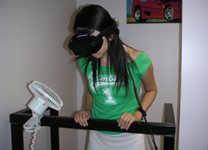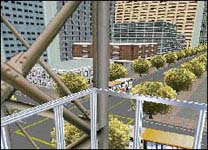Fear of Heights
 |
 |
Acrophobia, or the fear of heights, is characterized by an irrational fear of height situations resulting in the avoidance of such situations or the confrontation of such situations with marked distress. This fear for some is endured with distress, whereas for others the fear is so intense that height situations must be avoided altogether. Some may not be able to see a physician if his office is on the fifth floor, will not take a job because the office is on the tenth floor, or will not visit friends that move into an apartment three stories up.
This application consists of two virtual environments: 1) a virtual elevator and 2) a virtual cable car, that allow people with Acrophobia to be exposed to fearful situations related to heights. In each VR world, the therapist can present the patient with multiple stimuli as well as controlling the movement of the elevator or cable car. Real-time Bio-feedback provides the therapist with all of the patient’s vitals, including heart rate, respiration, skin conductance, temperature, electroencephalogram (EEG), and electrocardiogram (ECG). The optional head mount display (HMD) is equipped with a head tracker that detects the patient’s head rotations and position while navigating through the virtual world. During VR exposure therapy, the client stands on a custom built platform equipped with rails and a fan used to simulate tactile conditions of riding an outdoor elevator or cable car. Two speakers are mounted on the platform to facilitated immersion through audio stimuli.
For more in.0.formation or to schedule an appointment, email us at frontoffice@vrphobia.com or call us at (858) 642-0267.
